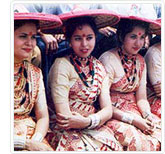Assamese New Year
Bohag Bihu is the national festival of Assamese as it marks the beginning of the New Year. Rituals and customary practices of Bohag Bihu starts from April 13. There are three forms of a Bihu festival namely Bohag Bihu or Rongali Bihu (in the middle of April), Magh Bihu or Bhogali Bihu (middle of January) and Kaati Bihu or Kongali Bihu (in October/ November).
 Bohag Bihu is the most important day of all the three Bihu festivals. This day begins with the sowing of seeds, Kaati Bihu marks the complete process of sowing and transplanting of paddies, and the Magh Bihu marks the end of the harvesting period.
Bohag Bihu is the most important day of all the three Bihu festivals. This day begins with the sowing of seeds, Kaati Bihu marks the complete process of sowing and transplanting of paddies, and the Magh Bihu marks the end of the harvesting period. Bohag Bihu
Bohag Bihu reflects the coming of spring and usually falls on April 15 every year. It is celebrated with distinctive Bihu dances. People are in full form and dance on various Bihu geets called husuris. This festival lasts for several days. People wear new and traditional clothes like dhoti, gamocha and saadar mekhela.
Bohag Bihu Celebrations
The first day of Bohag Bihu is called Goru Bihu or Cow Festival. Cow being the holy Hindu animal is washed, bedecked and worshiped on this day. On the eve of Bohag Bihu, the womenfolk clean clothes and prepare special Bihu delicacies like 'Chira' & 'Pitha' while men collect necessary items like 'Tara Pogha' (ropes for the cattle). This day is followed by Manuh (human) Bihu on April 15, the New Year Day on which homage is paid to elders and relatives. The next day after this is called vGosain Bihu. On this day religious activities take place.
Bohag Bihu is a dance festival. Groups of boys and girls beat drums and perform their traditional dance. Bihu fairs are organised to perform Bihu songs, theatrical performances and dance. Best woman dancer is awarded the title of Bihu Kunwori. Bihu festival has become such a major festival that even books, audio and video cassettes have come up in large numbers narrating the festival events.
New Year in Different Parts of India
New Year Special